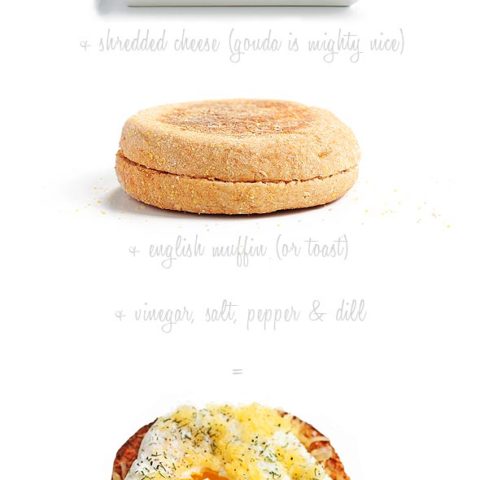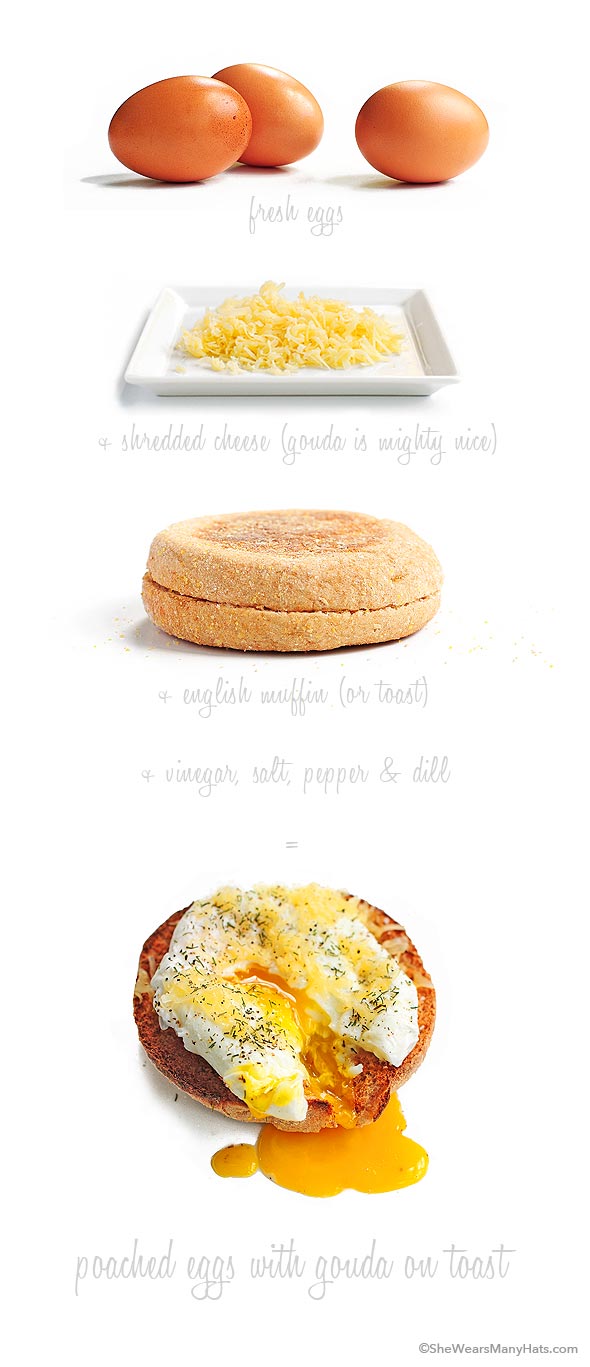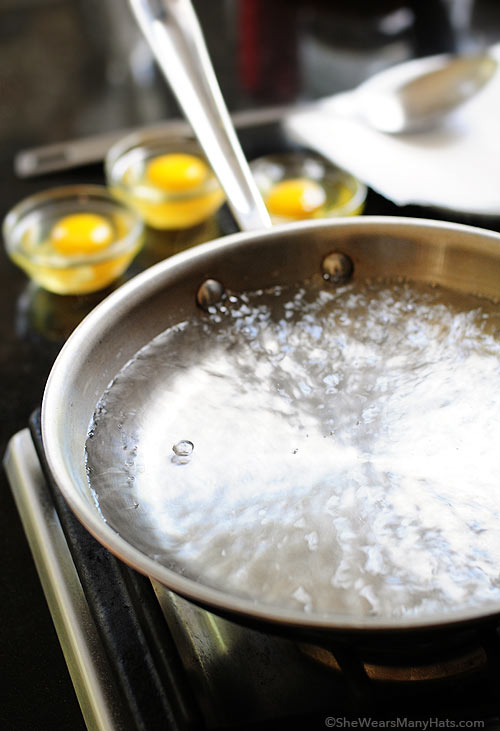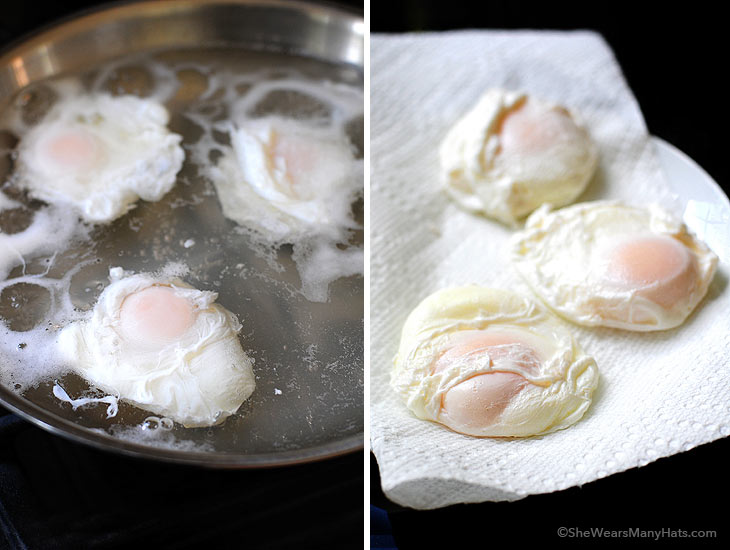Poached Eggs with Gouda on Toast
This post may contain Amazon or other affiliate links. As an Amazon Associate I earn from qualifying purchases.
Knowing how to poach eggs is a good thing to know especially when you can make yourself a simple yet satisfying breakfast like Poached Eggs with Gouda on Toast. This is one of my personal favorite dishes to enjoy for breakfast any day of the week. If you’ve never poached eggs before, be sure to read all the details below and start poaching today!
Sometimes I just want to share a favorite recipe. Sometimes I don’t have a story to accompany said recipe. Sometimes I just want to post some pictures, and the recipe, and be done with it. But that’s not the norm in the food writing/blogging world. Sometimes I don’t have jazzy words to describe the taste. Sometimes all I want to say is “try this recipe, because it’s good.” But “good” is unacceptable in the food writing world. “Good” doesn’t cut it.
But today I’m breaking the food writing rules. Maybe they’ll banish me from all that is food and writing. Maybe. But sometimes, sometimes you just have to break the rules.
So here’s my recipe: Poached Eggs with Gouda on Toast. Nothing fancy. Nothing especially interesting. But sometimes, those are the best kind of dishes ever. And this is that sometime. Try it. You’ll like it. It’s really good. Good, I tell ya.
With that said, I do have a little to say about the poached egg. It’s one of those basic foods that everyone should know how to cook. There’s nothing quite like it. It can be paired with a number of sides, and not just for breakfast. You’ll find an abundance of techniques online for how to poach an egg, but the best way, is whatever way you master and feel comfortable with. Because an egg unpoached is a sad, sad thing.
A couple of years ago I had the pleasure of being shown some tricks for poaching eggs by Jeffrey Saad. Jeffrey is one of those people with an infectious energy. Truly, truly a gem. He and his wife are some of the nicest people you could ever meet. Anyway, Jeffrey shared a few tips for poaching that I’ve used ever since, with regular success. Some of these are his tips, others I’m not sure where I heard them.
Tips for Cooking Poached Eggs
- Use a shallow pan for poaching. I use my 10″ fry pan. The shallow sided pan is easier to work with when retrieving the perfect poached pouch, as well as it gives less space for the egg to disperse.
- Add salt and vinegar to the poaching water. Salt adds taste, vinegar helps the egg white hold together. Really, try it with and without the vinegar and see the difference. Vinegar, such an all-purpose handy thing.
- Use fresh eggs. The whites of fresh eggs hold together better. Did you know that fresh eggs have cloudy whites? I know, weird. Kinda backwards even.
- Crack eggs into individual small bowls. You can certainly crack eggs directly into the poaching water, but cracking them into small bowls first allows you to gently place the egg into the water. The small bowl can even be immersed partway to let the egg gently glide into the water, which helps it stay together. Plus, if you’re not an excellent egg cracker, it gives you the chance to remove any shells before poaching.
- Another thing I do, (and I can’t remember if Jeffrey shared this with me or if I just can’t leave things alone), if needed, I use the tip of a spoon to gently nudge the egg white back to the center of the yolk right after dropping the egg in the water.
- Poaching time depends on temperature of water and how you prefer your eggs. I like mine poached for a little over 2 minutes. My husband likes his poached between 3-4 minutes.
If you’d like to see him perform the poach in person, Jeffrey has a video on how to poach eggs.
These tips are helpful, but once you play with poaching, you’ll find your personal little nuances to help create perfect poached eggs each time.
A few other notes on this recipe (and I thought all I had to say about this was that it was ‘”good”):
- You’ll notice I used a very small amount of cheese. I like the egg to play center stage here, plus with gouda (any cheese would do, but gouda is good), you don’t need much to add great flavor.
- Personally, a toasted English Muffin is the prime pocketed place for a poached egg to perch, but any toast that is to your liking will do.
- Salt, pepper and dill were added for the final touch. Dill + Eggs = Goodness.
Be sure to try out different combinations of cheese, breads, and seasonings. Once you master the poached egg, you’ll find your mind swirling with ideas for recipes of how to incorporate them into other dishes, and not just those for breakfast!
Poached Eggs with Gouda on Toast Recipe

Poached Eggs with Gouda on Toast
Poached Eggs with Gouda on Toast. Nothing fancy. Nothing especially interesting. But sometimes, those are the best kind of dishes ever. And this is that sometime. Try it. You'll like it.
Ingredients
- 2 fresh eggs
- 1 - 2 teaspoons salt*
- 1 tablespoon vinegar of choice*
- 1 English Muffin, toasted
- 1 ounce gouda, shredded (or favorite cheese, and more or less to taste)
- pinch or two of dill
- salt and pepper to taste
- * Salt and vinegar amounts for poaching water are approximates and based on 4 cups of water. Adjust accordingly.
Instructions
- Fill a sauté pan with approximately 1 1/2-inches deep with water. Add salt and vinegar to poaching water. Bring water to a low boil over medium-high heat, and reduce heat to barely a simmer. (If you like to measure things, 180-190-degrees F would be perfect temperature.)
- Crack eggs into individual bowls/saucers. Gently slide eggs one at a time into the poaching water. Using a spoon, gently nudge the egg whites toward center of yolk. Cook for 2-3 minutes for a semi-soft yolk or 3-4 minutes for a firmer-set yolk.
- With a spoon, remove eggs one at a time and drain on a plate lined with paper towels.
- Using one half of toasted English Muffin, add a little of the shredded cheese, then the poached egg, and top with a little more cheese. Season with a pinch of dill, salt and pepper.
Updated 1/25/15. Originally posted 9/11/12.







Those are some beautiful eggs.
Your pictures are so pretty!
I love this idea and will go get some Gouda .I invested in a egg poach pan and really love it.
Hello Bonnie,
Poaching has become one of our favorite ways to enjoy eggs. And Gouda … oh my!
This looks so good! I’m embarrased to admit that I have never had poached eggs. It’s about time. I need to try this!
Great read on the aspect of being descriptive but those eggs are hidious! Why would you use a shallow pan and not a pot so they get a round shape and not a flat shape like a fried egg? I just find it odd! Like you said though.. practice and find ways that work best for you and you like…. but they are ugly looking eggs and I wouldn’t want to eat those if I saw them at my mother’s house or a restaurant.
A popular chef taught me the method and it has worked well ever since. Have a lovely day, Vanessa!